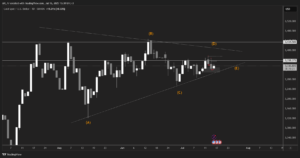Citibank analysts say gold prices could rise to $3,000 over the next 12 months, as a combination of strong physical demand, central bank purchases, and macroeconomic factors continue to support the bullish outlook for the yellow metal.
“The gold price path is unlikely to be linear, but average prices are expected to trend higher in the second half of 24 and 2025,” Citibank analysts wrote in a note. “We see the market well supported above $2,000-2,200/oz and regularly testing nominal price highs into end-2024,” before surging to $3,000 in 2025.
Several key factors support this bullish outlook. First, the market’s risk-adjusted skew has already shown resilience, with gold prices rising to $2,400 an ounce despite a strong US dollar, rising interest rates, and strong equity markets.
“A negative shift in US growth exceptionalism is supposed to be gold-positive, boosting longer-term demand and safe-haven assets, all else equal,” the note continued. “In a 6-12 month framework, Citi sees risks skewed towards weaker growth and lower yields. The uncertainty surrounding the US elections and a potential ‘red wave’ could lead to fiscal deficits widening and long-term interest rates rising, boosting gold’s demand over alternative assets.”
The potential for higher interest rates also supports this optimistic outlook. The easing cycle from the Federal Reserve, along with rising Treasury markets, is expected to be a major bullish factor for gold. Citibank economists also expect a US recession later in the second half of 2024, which could spur lower yields and higher gold prices.
Citibank also points to strong retail demand from China, noting that Chinese consumers are hoarding gold at record rates. “Healthy Chinese gold premia suggest demand is pent-up and could remain strong,” the analysts said.Turning to other precious metals, Citibank also has a bullish outlook for silver and copper. They expect silver prices to rise to around $38 an ounce over the next year, driven by strong industrial demand, particularly from the solar and electric vehicle sectors. For copper, the analysts expect a new record high of $12,000 per tonne by the end of the year, supported by China’s energy transition initiatives and expected grid-related stimulus.
Bank of Japan Likely to Keep Ultra-Low Interest Rates
In a move to address its massive monetary stimulus, the Bank of Japan is expected to keep its ultra-low interest rates at its meeting concluding on Friday. The central bank is also considering shrinking its balance sheet, signaling a cautious retreat from its expansionary monetary policy.
Despite the Bank of Japan’s intentions to normalize policy, challenges remain due to weak consumption and doubts about the bank’s forecast that strong domestic demand will keep inflation at its 2% target. The potential for less frequent US interest rate cuts could further complicate the Bank of Japan’s policy decisions by keeping the yen weak against the dollar, which has been a source of concern for policymakers by raising import prices and living costs, thereby weakening consumption.
Attention will focus on how Governor Kazuo Ueda will balance the recent economic slowdown with the bank’s forecast of steady progress towards the inflation target in his post-meeting briefing. The Bank of Japan’s target short-term policy interest rate is expected to remain between 0-0.1%. To address market concerns about how the Bank of Japan will shrink its $5 trillion balance sheet, the central bank could reduce its bond purchases or provide hints about its future tapering strategy.
A Reuters poll found that nearly two-thirds of economists expect the Bank of Japan to start reducing its monthly bond purchases, which currently stand at around 6 trillion yen ($38 billion), on Friday. This initial step towards policy normalization by the Bank of Japan comes as other central banks have already implemented tightening measures to address high inflation and are now considering rate cuts. The Federal Reserve kept interest rates unchanged on Wednesday, suggesting the possibility of one rate cut this year, while the European Central Bank cut interest rates last week for the first time since 2019.
The Bank of Japan emerged from negative interest rates and yield curve control in March, and moved away from suggesting it would continue to raise short-term rates to a neutral level, which analysts believe is around 1-2%. Governor Ueda has maintained that rising wages will support Japan’s recovery, even after the economy contracted in the first quarter. The Bank of Japan (BOJ) is under increasing pressure to tighten its monetary policy and reduce its massive balance sheet to ensure that future interest rate hikes have a more effective impact on the economy. Markets are closely watching the central bank’s next move as concerns about the effectiveness of its ultra-accommodative stance grow.
Cocoa Prices Jump Above $10,000 Amid Supply Concerns
Cocoa prices have surged above $10,000 per metric ton as the chocolate industry grapples with a worsening supply crisis. The situation has escalated with Côte d’Ivoire, the world’s largest cocoa producer, halting exports for June and suspending forward sales for the upcoming season. This comes on the heels of reports that Ghana, the second-largest cocoa producer, may delay the delivery of up to 350,000 tons of beans for the next season due to poor harvests.
Cocoa prices have seen a dramatic increase this year, more than doubling in value, and are currently more expensive than many metals. On the ICE exchange, New York cocoa futures for September reached a six-week high of $10,308 per ton and closed up 2.6% at $10,110 per ton. According to one trader, the decline in crop sizes from Côte d’Ivoire and Ghana, which are down 30% from the previous year, represents a “major problem.” The market faces a near-term shortage of beans to meet demand, and there is uncertainty about how the shortfall will be made up.
Côte d’Ivoire has suspended cocoa purchases and exports for June to conserve enough stocks for local processors, who are running low on beans. This ban could extend beyond June and could impact multinational companies like Cargill, Barry Callebaut, CEMOI, and Olam. European factories expecting shipments from Côte d’Ivoire may need to seek alternative sources.
Furthermore, Côte d’Ivoire has halted forward sales for next season’s crop at 940,000 metric tons, down 35% from the previous year, pending clearer production estimates. The country sold its main crop from October/March 2023/24 in the October/March period, extending 150,000 tons of beans into the current mid-crop.
Ghana is also facing challenges with forward sales, considering rolling over 350,000 tons of beans due to uncertainty in crop forecasts. For the 2024/25 season, Ghana has only sold 100,000 tons forward. Ghana typically sells around 80% of its crop before the year, or between 750,000 and 850,000 tons. However, this season’s crop is not expected to exceed 500,000 tons, and there are concerns that next season may not see much improvement.
Other soft commodities have also seen price increases. Raw sugar for July rose 2.6% to 19.59 cents per pound, while white sugar for August gained 2.3% to 567.40 cents per pound. Coffee prices were mixed, with September robusta coffee prices closing slightly higher at $4093 per ton, while September arabica coffee prices rose 0.6% to $2.2625 per pound.
Disclaimer: This article is not investment advice or an investment recommendation and should not be considered as such. The information above is not an invitation to trade and it does not guarantee or predict future performance. The investor is solely responsible for the risk of their decisions. The analysis and commentary presented do not include any consideration of your personal investment objectives, financial circumstances, or needs.





